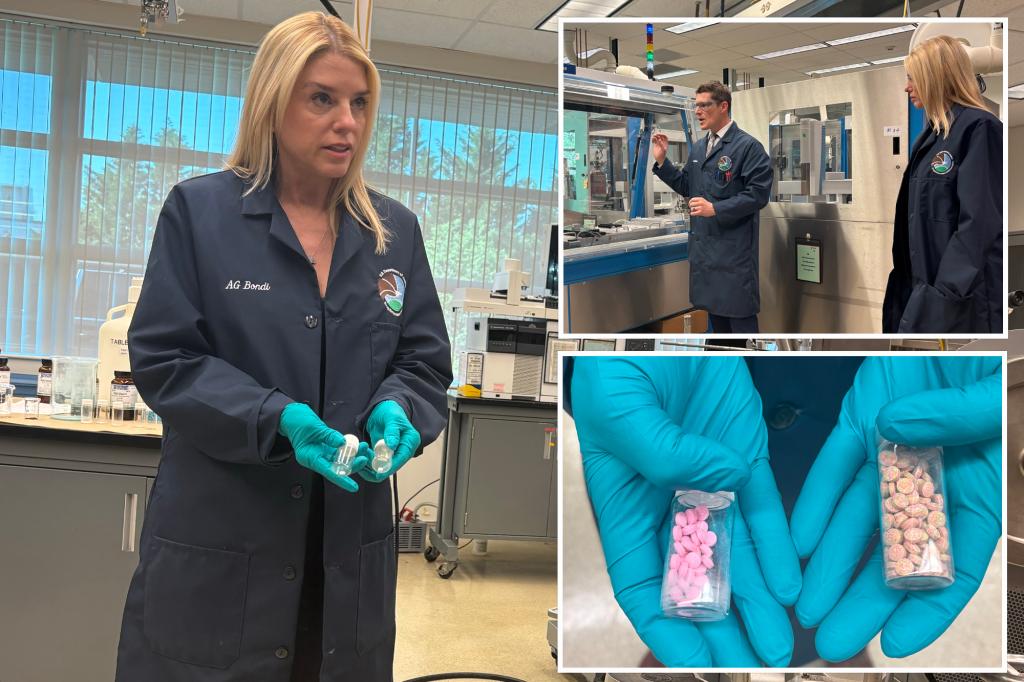Attorney General Pam Bondi toured the only federal lab in the country providing end-to-end analysis of the ingredients fueling fentanyl trafficking Tuesday, getting an up close and personal look at how deadly the synthetic opioid is — and how quickly it can be manufactured.
Drug Enforcement Agency (DEA) chemists briefed Bondi on the hardware, chemical components and scope of the drug trade at their Northern Virginia lab as part of National Fentanyl Awareness Day, before the AG shared shocking statistics with The Post and other reporters who accompanied her.
Since Jan. 1, the AG’s office revealed, the feds have seized enough fentanyl to kill 119 million Americans — roughly a third of the US population — with the Trump administration intercepting a massive 2,450 kilograms.
Fentanyl, which comes in bright blue and red colors due to the dyes used in production, is 10,000 times more potent than heroin — and even more dangerous versions, such as carfentanil, have been appearing that deliver 100,000 times the payload of heroin.
“This machine is making drugs that can kill millions of Americans,” Bondi said, placing her hand on a giant metal pill-maker cranking out small, counterfeit tablets at a rate of 333 per minute.
“Had this been real, we would all be dead in this room,” the AG said ominously as a plume of blue smoke escaped from the funnel through which powdery mix was being poured into the machine to produce the pills.
Traffickers usually produce a kilo in around three days of work, one of the DEA chemists noted. Each capsule can then be sold on the street for as little as $10.
One pure kilo of fentanyl can cause 500,000 potentially fatal overdoses, but traffickers rarely export with purity levels higher than 15%, a Justice Department official told The Post.
Some of the pills are colored with easily purchased bakery confections sold in grocery stores, such as the blue dyes used in Pillsbury-branded Funfetti.
David Guthrie, a senior DEA research chemist, said he and two other colleagues have worked to reproduce the recipes used by traffickers in order to help authorities better track fentanyl strands and the locations they’re originating from.
“We were able to show that this is not a process that’s necessarily going to turn out a kilogram of very dirty fentanyl, that’s very impure, that might not get the end user as high, [and] it might not be as deadly — it is very pure at the end,” Guthrie said.
“It took us four working days, about eight-hour days — the cartels don’t work eight-hour days,” he added. “They work sunup to sundown and possibly more.”
“I like to say that we’re kind of the government’s answer to Walter White from ‘Breaking Bad,’” Guthrie boasted. “We are trying to reverse-engineer what the cartels are doing at any given time.”
For decades, the DEA has been raiding cook sites and obtaining the industrial machines used to make fentanyl in both the US and Mexico. The devices are supposed to be registered with federal authorities — but have been known to pop up and be sold without a trace on websites such as Ebay.
“Mexico tends to get the higher-producing instruments while we have the smaller ones,” said senior forensic DEA chemist Jonathan Dumke.
“The smaller ones can be done in closets. They can be done in the trunk of cars, hotel rooms, while these,” added Dumke, pointing to the machine where Bondi was standing, “are more in factory, industrial settings.”
The chemist then picked out a blue capsule.
“One of these tablets contains about 2 mg,” he said, “so 2% of this tablet is the threshold to kill a person.”
The chemists guided Bondi through several rooms at the lab where they analyze real fentanyl and then reverse-engineer the chemicals that go into making the product, giving them a fuller picture of the supply chain.
Some components, like acetaminophen, are available over the counter, while others such as dipyrone are banned by the Food and Drug Administration (FDA) and have to be purchased in Mexico, Central America, or South America.
“How well the mix is will determine how the dye looks,” Dumke said of the intercepted pills the chemists have analyzed from cartels and traffickers by observing different dyes and blends used in the fentanyl powder.
“If you think of chocolate chip cookies, one cookie usually has a couple chocolates, another one will have a bunch more chocolates,” he explained. “So someone might get all the chocolate … they’re getting all the fentanyl. … but now your friend next to you on the couch–“
“Is dead,” Bondi interjected.
The DEA has mostly been seizing tablets with blue dyes, which are imported cheaply from China, in order to put together full ingredient lists, calculate how the tablets are being moved through the milling process — and then work with “the intelligence side” to find production sites.
“It’s a constant cat and mouse game,” said Guthrie.
President Trump has also given the DEA’s fentanyl crackdown a leg-up by deploying up to 145% tariffs on China to halt its export of precursor chemicals to Mexican cartels and other traffickers.
But fentanyl remains the leading cause of death for Americans between the ages of 18 and 44 and is costing the US health care system as much as $107 billion annually, according to the Centers for Disease Control and Prevention.
All told, the fentanyl trade cost the US around $2.7 trillion, or 10% of US GDP, in 2023.
Read the full article here

